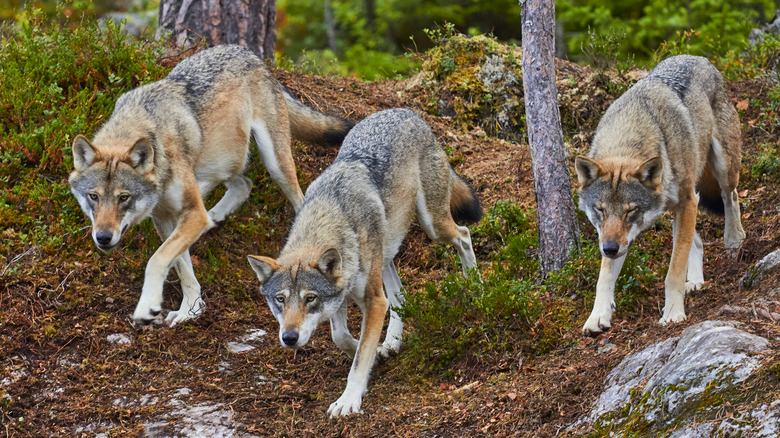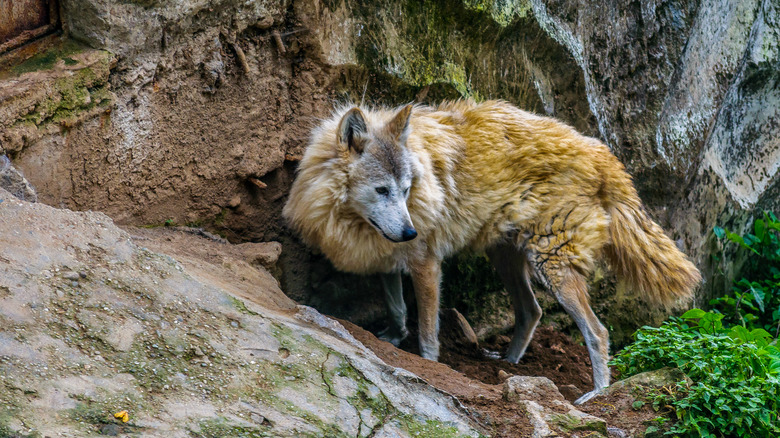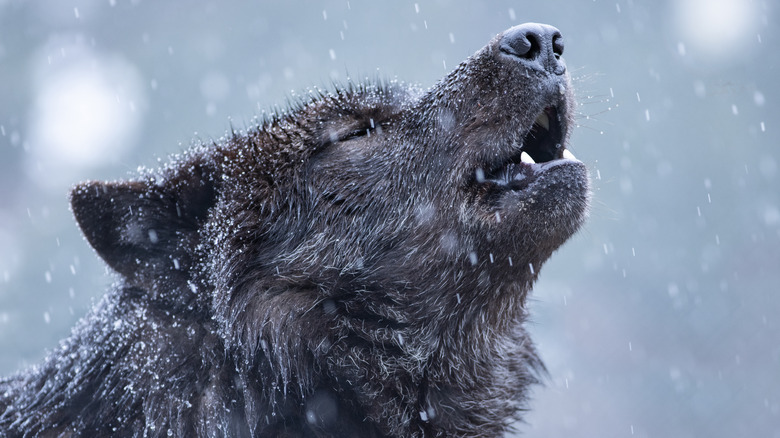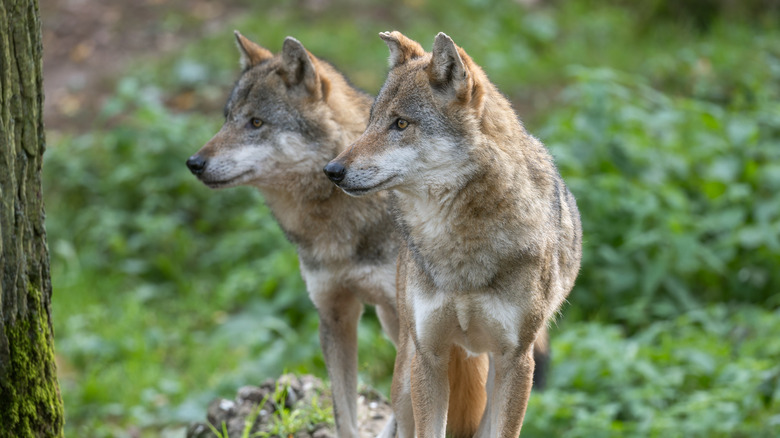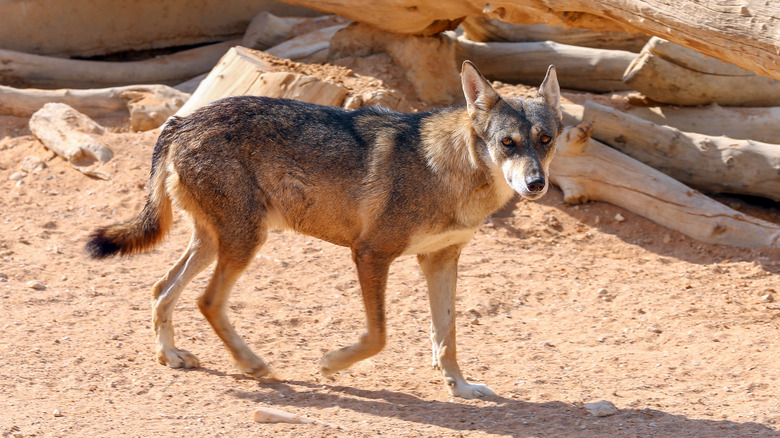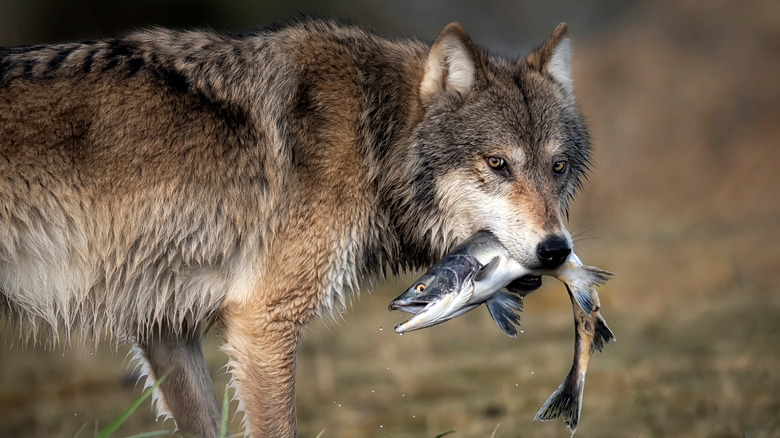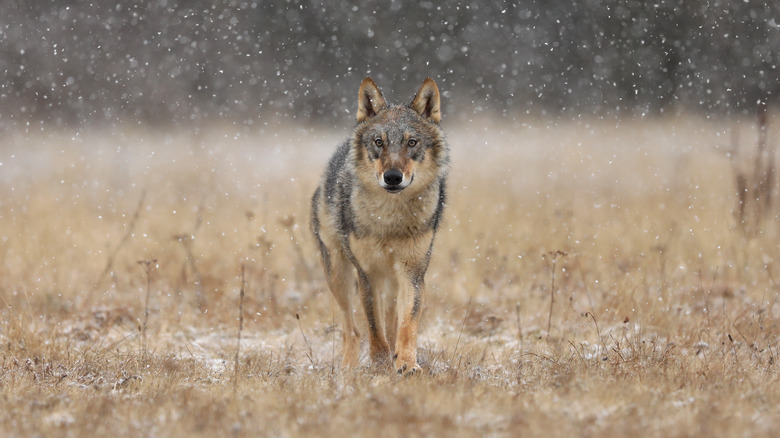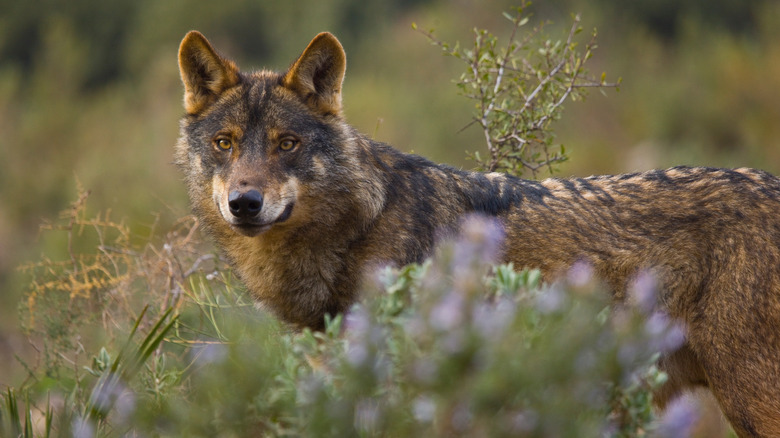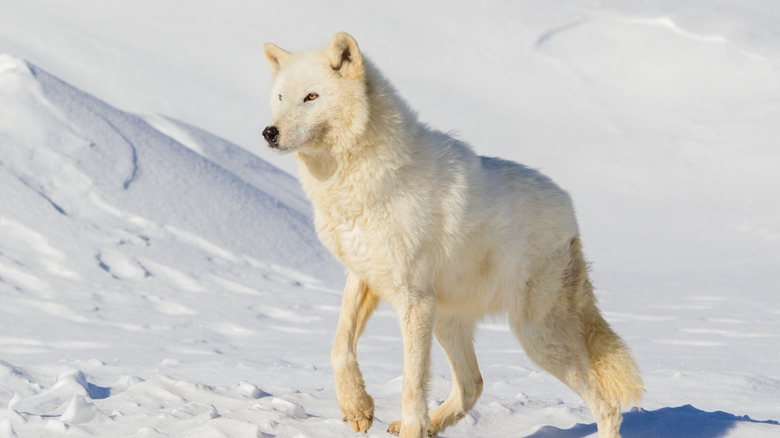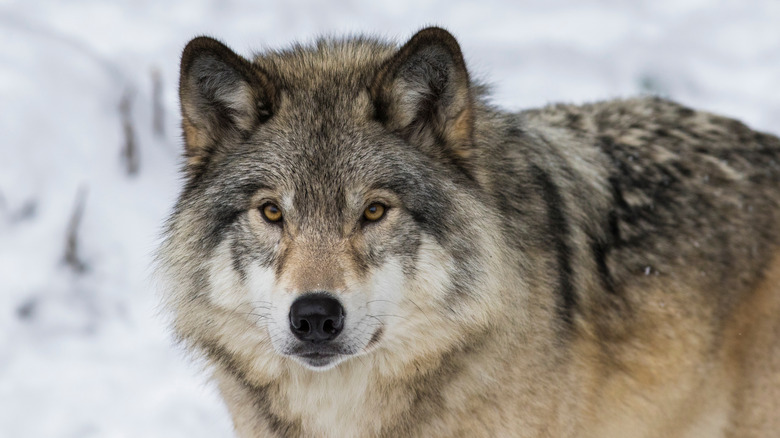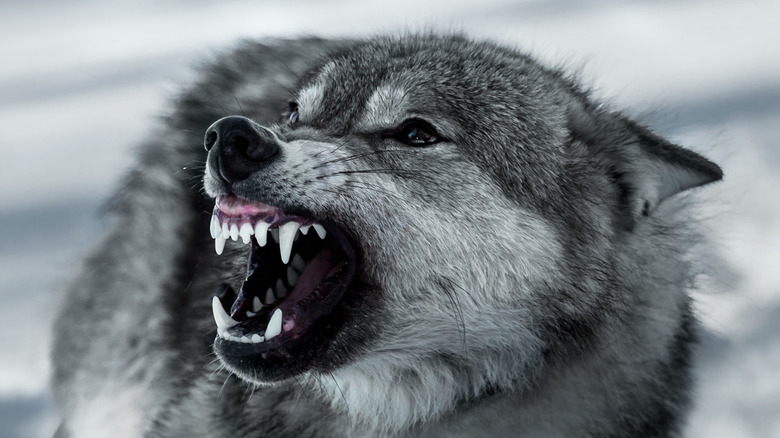10 Types Of Wolves, Ranked By Danger Level
Anyone who has seen the movie "The Grey" with Liam Neeson knows that wolves can be the stuff of nightmares. The movie follows an oil crew stranded in the Alaskan wilds after a plane crash. Wolves begin to pick them off one by one until only Neeson is left to take on the alpha. It is a haunting film. However, it does take liberties and dramatizes certain things about wolves. Still, the fact remains that wolves are the most dangerous canines to walk the earth.
The question is, how dangerous? Just as there are danger levels for animals like bears and crocodiles, so too are there danger levels for wolves. There are some wolves that will turn and leave you alone. There are others that will tear you apart if you get too close. The fact is that, regardless of their size and strength, there are dangerous animals out there in the world. Wolves are among them.
We've ranked this list with the wolves that are least dangerous to the ones that are the most dangerous. Our rankings are based primarily on size and strength, but aggression and the amount of human injuries or fatalities are also considered. Here are 10 types of wolves, ranked by danger level.
10. Himalayan wolf
The Himalayan wolf (Canis lupus chanco) is specially adapted to live in the high, mountainous regions of the Himalayas. Their range includes the country of Nepal, areas of northern India, and Tibet. An elusive species, Himalayan wolves are in something of a decline owing to the degradation of their natural habitat. This makes sightings and attacks from these wolves rare. However, this does not lessen their danger.
According to Brieflands, between the 14th and 20th centuries, Himalayan wolves killed around 7,600 people. Also noted in the case study was an attack on a 12-year-old boy. The damage caused by one of the wolves was extremely grizzly. Deep lacerations to the cheeks and forehead, near removal of the nose, and significant damage to the eyes were observed.
These are not uncommon results of any kind of wolf attack. Since they are apex predators with extremely powerful jaws and sharp teeth, the damage wolves can inflict has the potential to leave lasting impacts and could even be fatal. In the case of the Himalayan wolf, it is due to the dwindling numbers that we rank it our least dangerous wolf that should nevertheless be treated with extreme caution.
9. Black wolf
Black wolves certainly look as though they have crawled out of a gothic horror story. However, as it turns out, they are something of a rarity. Black wolves are the result of the ancient interbreeding of Gray wolves (Canis lupus) and early domesticated dogs. The resulting mutation caused the pigmentation of the fur to darken. The mixed breed is an animal with dark fur, powerful jaws, fast legs, and a potentially wicked temper.
Owing to their rarity, there have been very few instances of people being attacked by Black wolves. There was, however, a 2016 viral video of what appeared to be a Black wolf going after a hiker's dog. There is debate over whether or not the animal in question is real, but it is not out of the realm of possibility. Wild canines are more inclined to attack fellow domesticated canines, who they view as more of a threat than humans.
Though some Black wolves have been found in Europe, the majority live in North America. There have been several sightings in Canada, as well as the U.S. states of Minnesota and Wyoming. Speaking of Wyoming, Yellowstone National Park is actually home to a relatively large pack of Black wolves. Over 100 are known to be hunting within the park's borders. As the National Park Service notes, you are in wolf country, so be smart and leave them alone.
8. Eurasian wolf
The Eurasian wolf, also known as the European Wolf (Canis lupus lupus), has a range that extends across nearly all of continental Europe and into Asia. Widespread throughout much of the 18th century, the wolves were systematically exterminated throughout the ensuing centuries, right up to the Second World War. Today, they are primarily recolonized in Eastern European nations like Romania and the Balkans. As Europe is a densely populated continent, these wolves are very used to people, which can make them deadly.
Though they are typically forced to eat livestock and trash, Eurasian wolves are not above attacking people if they have to. Like most wolves, they will shy away from people on instinct. However, there is nevertheless a substantial fear caused by these creatures. As reported by the BBC in 2016, students in southern Russia received transport to school after they were found to be walking to school armed with axes in order to fend off wolves. There have even been reports in Estonia of these wolves killing and eating several people, per Wild Explained.
It is easy to see how the Eurasian wolf can instill so much fear. They regularly weigh over 100 pounds and have an extremely strong bite. The potential for them to be rabid is common, which adds yet another element of danger to this most common of wolves.
7. Arabian wolf
Though most wolves hunt in packs, the Arabian wolf (Canis lupus arabs) live in extremely small packs, often no more than three, and are omnivorous, due to the urbanization of their environment. As explained by TheTopMan 2.0, these wolves, sometimes dubbed "the monsters of the Sinai Peninsula," can be properly aggressive if provoked. Not exclusive to just the Sinai Peninsula, however, Arabian wolves are adapted to live in arid environments across the Middle East. They are naturally wary of humans but will hunt closer to settlements and even prey on livestock.
Arabian wolves are not big animals. In fact, they are the smallest wolf species on the planet. They do not tend to be more than two feet tall at the shoulder and generally weigh less than 60 pounds. However, this size does not mean that they cannot do their fair share of damage.
According to EarthTouch News Network, trash left by tourists led to a string of Arabian wolf attacks in Israel's Ein Gedi region. One instance involved a wolf attacking a one-year-old girl, though she gladly got away with only a few bite marks and scratches. This, however, is a best-case scenario. Had the wolf been successful in abducting the child, it most certainly would have consumed her.
6. Yukon wolf
The Yukon wolf (Canis lupus pambasileus) has a relatively small range in comparison to some of the other wolves on this list. Sticking primarily to Yukon, British Columbia, and Alberta in Canada, as well as inland Alaska, these canines can be extremely aggressive when properly provoked. A subspecies of Gray wolf, Yukon wolves, also known as Inner-Alaskan wolves, have white, black, tan, or gray fur and are on the larger side, typically weighing around 125 pounds when fully grown.
Though they tend to steer clear of humans, several attacks by these wolves have been reported. In 2019, according to CNN, a Yukon wolf attacked a family camping in Banff National Park. The wolf tore through the tent and sank its teeth into a man's arms, causing severe lacerations and bite marks. Other campers came to the rescue and managed to drive off the wolf. It is the only reported instance of a wolf attacking campers in a Canadian National Park, but not the only time one of these wolves has gone after a person.
Yukon News reported a wolf chasing a cyclist down a highway in Alaska in 2013 only narrowly missed biting the cyclist's foot. Typical hunting behavior for a Yukon wolf is to do so in packs and circle their prey so there is no chance of escape. Though these incidents involved lone wolves, these hunting tactics can be quite terrifying when you consider the fact that the prey could be you.
5. Steppe wolf
Located primarily around the Caspian Sea, the southern reaches of Siberia, and northern Kazakhstan, Steppe wolves (Canis lupus campestris) are part of the broader family of Siberian wolves, but have a tendency to be far more aggressive than their cousins. They live in packs and will battle with each other constantly. This aggressive behavior is translated to their hunting tactics.
Lone hunters, Steppe wolves have had many interactions with humans. The fights are primarily over livestock. Steppe wolves live closer to areas of human habitation than other Siberian wolves. Therefore, they have much more of an opportunity to interact with people. Known sheep killers, it is not uncommon to see one or several Steppe wolves devouring a lamb carcass in the middle of a field.
Though they are illegal to hunt in Russia, farmers are allowed to kill any wolf if that attacks their livestock. Such was the case in 2021, when, as the Daily Mail reported, an Eastern Russian farmer strangled a Steppe wolf to death with his bare hands. The beast had killed his two guard dogs and attacked his horse. The farmer did not walk away unscathed, leaving the battle with several lacerations and bites. He blamed the habitat degradation for the attack, saying that the wolf attacks on livestock will continue to increase as they lose more and more of their natural habitat.
4. Iberian wolf
The Iberian peninsula forms the western terminus of continental Europe and contains the nations of Spain and Portugal. It is also home to the Iberian wolf (Canis lupus signatus). An exceptionally tawny colored wolf, the Iberian is both taller and slimmer than its Eurasian cousins, and have defined black marks around their eyes and face. Iberian wolves have been considered endangered for some time, so much so that the Spanish government has put a ban on the hunting of them.
Much like the issues farmers have faced with the eastern Steppe wolves, Iberian wolves have only grown in number, and had a tremendous impact on the livestock of the region. Early on in their recolonization, as reported by The Guardian reported in 2014, hundreds of sheep and cattle were killed by wolves. As of 2019, that number has increased to over 3,000 animals and nearly tens of thousands of euros in financial losses, per the BBC.
Because farmers have a duty to defend their livestock, they will likely have to contend with wolves more than ever before. And seeing as Iberian wolves can weigh over 100 pounds, run up to 31 mph, and have incredibly sharp, powerful jaws, interactions with one will undoubtedly mean severe injury, and potential death.
3. Arctic wolf
One of the fastest wolves on the planet, with a top speed of 46 mph, the Arctic wolf (Canis lupus arctos) is among the more dangerous of the wolf species. It is adapted to live in some of the coldest reaches of the Earth, and is decidedly smaller than some of its brethren, the bite force is powerful and they have a propensity to find food wherever they can owing to the potential for scarcity in the harsh terrain.
It is precisely because of where they live that Arctic wolves can be so dangerous. They do not come into regular contact with people. As a result, they do not fear them the way other wolves do. On the contrary, Arctic wolves are actually rather curious. As The Telegraph reported in 2015, Arctic wolves amiably strolled up to some Canadian workers, even going so far as allowing them to pet them. As is the case with some of the world's deadliest snakes, it can be the seemingly most kind species that are also the most deadly.
This point hit home in 1915 when, according to a journal published in Arctic Wolf Attacks Scientist: A Unique Canadian Incident, a large Arctic wolf attacked a scientist on an Arctic expedition. The last known attack by an Arctic wolf was in 1942. So, despite the rarity of Arctic wolf encounters and the potential to be amiable, they remain incredibly dangerous animals that should not be approached.
2. Northwestern wolf
This single subspecies has the most names of any wolf on this list. Simultaneously known as the Mackenzie Valley wolf, the Alaskan timber wolf, and the Canadian timber wolf, the Northwestern wolf (Canis lupus occidentalis) is perhaps the most dangerous subspecies on this entire list. Known to kill people when properly disturbed, it is the size and power of this wolf that is truly terrifying to know.
According to the Daily Science Journal, these wolves are the largest in the world, growing in excess of 7 feet long. This length brings with it additional weight and additional power to the jaws. Northwestern wolves have a bite force of around 400 psi. This is enough to shatter bone and more than enough to tear off appendages. Seeing as these wolves routinely take down elk and moose, just imagine what they could do to you if you crossed one.
An attack from one could leave you seriously injured, which was the case in British Columbia in 2020. According to CBC, a 70-year old man was mauled by a wolf and flown to hospital in Vancouver for treatment on the serious injuries left on the man's lower body. Though these incidents are incredibly rare, the fact remains that these animals, especially ones the size of the Northwestern wolf, have the capacity to kill with ease.
1. Gray wolf
All of the wolves we have listed on this list have been subspecies of one wolf: the Gray wolf (Canis lupus). The largest species of wolf in the entire world, you will not find another that is more outwardly aggressive towards humans. These are the wolves "The Grey" made seem so terrifying. Though many of them do try to avoid human contact whenever possible, the fact remains that when they are properly provoked, and even sometimes when they are not, they will kill people. All one needs to do is look at history.
Over 200 years ago, in 1820s Sweden, a Gray wolf went on a rampage. According to Wolf Song of Alaska, this is the single deadliest wolf in all of recorded history. This wolf, known locally as the Wolf of Gysinge, is directly responsible for the death of 12 people, 11 of whom were children. This killing spree occurred over a 3-month period before the wolf was finally stopped and killed. Imagine the terror of these villagers, and you'll understand why Gray wolves are the most dangerous in the world.
While wolves may remind us of larger, fuzzier versions of our beloved dogs, they remain incredibly dangerous creatures. They can kill you if you are not careful. And while it is not altogether common for them to do so, the fact that they can should leave you more wary than comforted.
